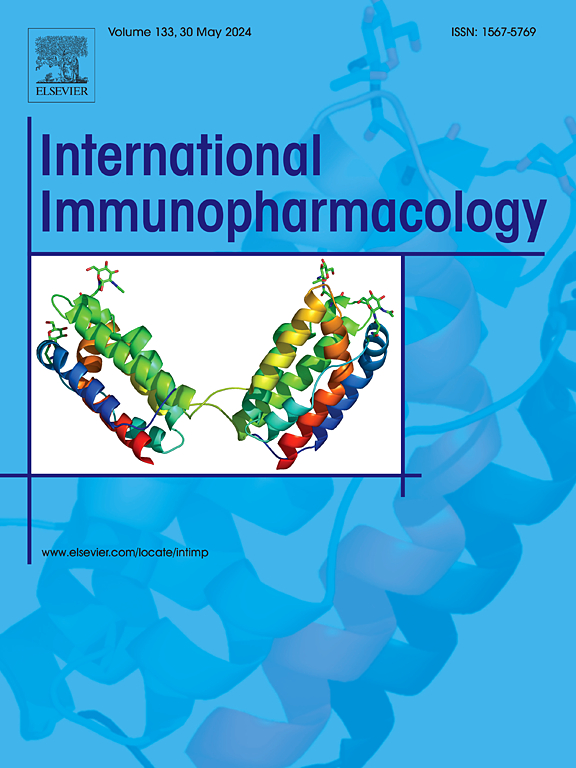Therapeutic targeting the cGAS−STING pathway associated with protein and gene: An emerging and promising novel strategy for aging-related neurodegenerative disease
IF 4.7
2区 医学
Q2 IMMUNOLOGY
引用次数: 0
Abstract
Neurodegenerative diseases (NDDs) represent a rapidly escalating global health challenge, contributing significantly to the worldwide disease burden and posing substantial threats to public health systems across nations. Among the many risk factors for neurodegeneration, aging is the major risk factor. In the context of aging, multiple factors lead to the release of endogenous DNA (especially mitochondrial DNA, mtDNA), which is an important trigger for the activation of the cGAS–STING innate immune pathway. Recent studies have identified an increasing role for activation of the cGAS–STING signaling pathway as a driver of senescence-associated secretory phenotypes (SASPs) in aging and NDDs. The cGAS–STING pathway mediates the immune sensing of DNA and is a key driver of chronic inflammation and functional decline during the aging process. Blocking cGAS–STING signaling may reduce the inflammatory response by preventing mtDNA release and enhancing mitophagy. Targeted inhibition of the cGAS–STING pathway by biological macromolecules such as natural products shows promise in therapeutic strategies for age-related NDDs. This review aims to systematically and comprehensively introduces the role of the cGAS–STING pathway in age-related NDDs in the context of aging while revealing the molecular mechanisms of the cGAS–STING pathway and its downstream signaling pathways and to develop more targeted and effective therapeutic strategies for NDDs.
靶向与蛋白质和基因相关的cGAS - STING通路:一种新兴的、有前途的治疗衰老相关神经退行性疾病的新策略
神经退行性疾病(ndd)是一项迅速升级的全球卫生挑战,严重加重了全球疾病负担,并对各国公共卫生系统构成重大威胁。在神经退行性疾病的诸多危险因素中,衰老是主要的危险因素。在衰老的背景下,多种因素导致内源性DNA(尤其是线粒体DNA, mtDNA)的释放,是cGAS-STING先天免疫通路激活的重要触发因素。最近的研究发现,cGAS-STING信号通路的激活在衰老和ndd中作为衰老相关分泌表型(sasp)的驱动因素的作用越来越大。cGAS-STING通路介导DNA的免疫感知,是衰老过程中慢性炎症和功能下降的关键驱动因素。阻断cGAS-STING信号可能通过阻止mtDNA释放和增强线粒体自噬来减少炎症反应。生物大分子(如天然产物)对cGAS-STING通路的靶向抑制为年龄相关ndd的治疗策略提供了希望。本文旨在系统、全面地介绍衰老背景下cGAS-STING通路在年龄相关性ndd中的作用,揭示cGAS-STING通路及其下游信号通路的分子机制,为ndd的治疗提供更有针对性、更有效的治疗策略。
本文章由计算机程序翻译,如有差异,请以英文原文为准。
求助全文
约1分钟内获得全文
求助全文
来源期刊
CiteScore
8.40
自引率
3.60%
发文量
935
审稿时长
53 days
期刊介绍:
International Immunopharmacology is the primary vehicle for the publication of original research papers pertinent to the overlapping areas of immunology, pharmacology, cytokine biology, immunotherapy, immunopathology and immunotoxicology. Review articles that encompass these subjects are also welcome.
The subject material appropriate for submission includes:
• Clinical studies employing immunotherapy of any type including the use of: bacterial and chemical agents; thymic hormones, interferon, lymphokines, etc., in transplantation and diseases such as cancer, immunodeficiency, chronic infection and allergic, inflammatory or autoimmune disorders.
• Studies on the mechanisms of action of these agents for specific parameters of immune competence as well as the overall clinical state.
• Pre-clinical animal studies and in vitro studies on mechanisms of action with immunopotentiators, immunomodulators, immunoadjuvants and other pharmacological agents active on cells participating in immune or allergic responses.
• Pharmacological compounds, microbial products and toxicological agents that affect the lymphoid system, and their mechanisms of action.
• Agents that activate genes or modify transcription and translation within the immune response.
• Substances activated, generated, or released through immunologic or related pathways that are pharmacologically active.
• Production, function and regulation of cytokines and their receptors.
• Classical pharmacological studies on the effects of chemokines and bioactive factors released during immunological reactions.

 求助内容:
求助内容: 应助结果提醒方式:
应助结果提醒方式:


